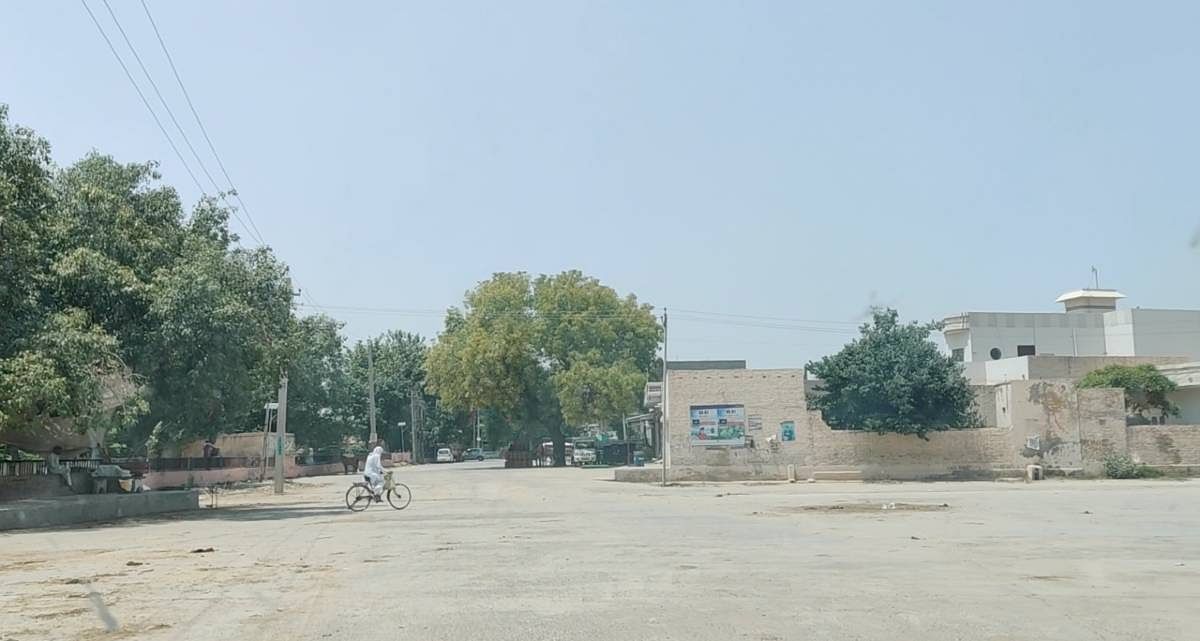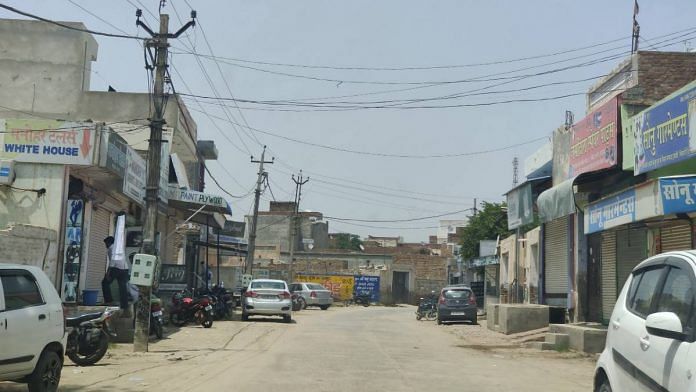Sirsa: Chautala village in Haryana’s Sirsa district is a far cry from the bustling small town image presented by the other villages in the neighbourhood.
Here, the roads are deserted, no one can be found under the Banyan tree at the chaupal—a meeting spot for the village’s elderly. Shops are closed and the stage and tents that had been set up at a protest site in the village, in support of the farmers’ agitation against the three agricultural laws passed last year, has been dismantled.
“At the beginning of this month, 16 people died of Covid in our village, in one single day. That is when everyone realised that this virus is deadly and will spare no one,” said Dinesh Kumar, a farmer and resident of Chautala village.
The ancestral village of Om Prakash Chautala, former chief minister of Haryana, had come out in full support of the ongoing farmers’ agitation at Delhi’s Tikri and Kundli borders, but the fear of catching Covid seems to have dulled their zeal for the moment. The villagers, most of whom are farmers, now prefer staying at home.
Chautala village, with a population of over 15,000 people, is one of eight “high risk” villages in Chautala block, comprising 35 other villages, according to data shared by the Community Health Center (CHC). Over 40 Covid-related deaths have been reported in the village since 1 May, said the villagers, though the CHC data showed only 34 Covid deaths across the block. As on 28 May, there were 220 active cases across the block, of which 128 cases were in Chautala village alone, according to CHC figures.
Lack of health infrastructure – shortage of beds with oxygen support, for example – added to the crisis. The CHC received 17 oxygen concentrators in May from the Jannayak Janata Party (JJP), which is in opposition in the assembly constituency (though it is a part of the ruling coalition in the state government), but now a game of political rivalry has started over the pandemic management here.
Meanwhile, a Covid Isolation Centre set up by the state government at a school in the village remains deserted, as without doctors or proper medical facilities, it is deemed to be of little use by the villagers.
Also read: Farmer unions seek PM Modi’s intervention to resume talks, threaten bigger agitation
Putting the protest on hold
Most of the residents of Chautala are farmers. The decision to put the protest against the farm laws on hold, was a difficult one, but was taken unanimously on 2 May, after the number of deaths in the village began to rise, villagers told ThePrint.
“We decided to put the protest on hold and be indoors till the number of cases came down,” explained Dinesh Kumar.

A senior government official told ThePrint said that the maximum number of participants at the farmers agitation being carried on at the Delhi border were from Chuatala village, though there is no available data to support it.
“Since Chautala village has a huge population of farmers, at least four to five members of every family went to the borders to join the agitation. For those who couldn’t go to the border, they started a sit-in protest right at the entry point of the village. We never really thought they would take the pandemic seriously and withdraw the protest here, but we are glad that they have,” the official said.
The villagers insisted that the withdrawal of protest at the village is only temporary.
“This entire village is of farmers and hence everyone here participated in the agitation. From each household, four-five people would sit in protest all day. We also took turns to go to the border in Delhi. We had arranged for tea and food for the farmers who came from other villages to join the protest. Now, since Covid is spreading fast and so many have died, we are scared,” said Ashok Kumar, who sells vegetables in the village.
“Once this time passes, we will again join the agitation in full force,” he said with conviction.
The belief is shared by nearly everyone in the village. “Once the Covid cases come down…”, is a thought on every mind.
Manphool Singh, a leader of the farmers’ association the Sayunkt Kisan Morcha, had been coordinating the movement of farmers from his village to the Delhi border till recently, but now spends time indoors, reading the paper and resting.
“We gathered people, we mobilised them. I myself went to the borders for months, but now the situation demands that we stay indoors. However, it does not mean that we have withdrawn. It is just a matter of time,” said Singh.
Also read: Haryana town had spanking new hospital with O2 tank, but it was of no use in peak Covid crisis
’15 beds with oxygen support for population of about 3 lakh’
By mid-April, an increasing number of people in Chautala and the adjoining villages, had started showing Covid-like symptoms, thus increasing the patient load at the CHC in the block. The single CHC caters to patients from 36 villages.
The CHC had only 15 beds with oxygen support, for a population nearing three lakhs. There were no oxygen concentrators or ventilators. Unable to tend to the patients, the CHC started referring patients to the Sirsa district hospital, which too was functioning at full capacity and beyond, the CHC staff told ThePrint.
Then, in May, the CHC received 17 oxygen concentrators from the JJP.
“We did not have any oxygen concentrators and none were provided by the state authorities. It was only after the JJP donated them that could give some relied to patients. Before that any patient who would need oxygen support for longer periods would be sent to the district hospital in Sirsa,” a doctor at the CHC said, on condition of anonymity.
Speaking to ThePrint, the constituency’s Congress MLA, Amit Sihag, agreed that the health infrastructure in the area was “inadequate to deal with the Covid wave”. He, however, said that his party has taken several measures, including setting up of an oxygen plant in the constituency, sanitising Covid hotspots and starting a personal helpline for the needy, to strengthen the healthcare facilities in the area.
“We ensured that the Dabvali hospital in the district, which has 50 beds, is turned into a Covid care facility and also arranged for oxygen concentrators. Since, it was still not sufficient, we planned to have our own oxygen plant and I got the necessary approvals and spoke to a private company to help set it up,” he said.
Though the plant is yet to be set up, Sihad said with apparent pride, “Today, Dabvali [in Sirsa] is going to have its own oxygen plant, with a capacity to generate 500 litres of oxygen per minute. The plant has ben imported from Australia and has reached India and should be put in place by next week. This will ensure continuous supply of oxygen for patients here,” he said.
JJP member Sarabjeet Singh Maseeta, however, accused Sihag of not “stepping out in the field when the people needed him the most.”
“It was a very bad time for this constituency and he was nowhere on the field. There were no tests being conducted, people were falling sick and dying, there was no oxygen available in hospitals. That is when we decided to help out and gave 17 oxygen concentrators to the hospital to make sure that the villagers do not have to run to the already crowded district hospital,” he said.
Also read: Delhi, ‘friends’, farmers — how Covid surged in Sonipat, peaked at positivity rate of 57%
A Covid isolation centre that has no patients
Vijay Arya, a junior teacher at the senior secondary boys school in Chautala, was perched on a broken chair, as he surfed through videos on his phone.
Though whiling away the time, Arya was on duty – not as a teacher, but at the Covid isolation centre that has been set up by the state in the school premises. The isolation centre consists of 10 single beds, for “emergency situations”.

“The centre was opened on 4 May, but no patient has come here yet. The centre is open 24X7 and all teachers work on rotation for four-hour shifts. Although there is no doctor on duty here, we have been given their phone numbers, along with other emergency numbers that we can immediately dial from our control room here to seek help,” Arya said.
But without any oxygen supply, medicines or doctor on duty, villagers said going to isolation centre would be adding further “risk to their lives”.
“Why should we come to this center when there is no doctor here? Will a teacher treat us now? It is better to go to the CHC, where we can find doctors. They may say that this isolation center is to help us, but it is a sham. There is nothing here accept some beds,” Dhanna Ram, a resident said.
Arya may explain that the center was for people who did not have the scope to isolate at home, but the villagers are not convinced.
“This was made for emergencies. In case a person is unable to isolate at home, they can come here. We have some basic medicine, like paracetamol, that we can give the patients. We have been trained,” he said, but he had to admit that they will be of no help to those who are in need of critical medical attention.
“We have a list of numbers that we can call. Or direct the patients to the CHC. This is just for patients who are not critical,” he admitted.
(Edited by Poulomi Banerjee)
Also read: Protesting farmers call Covid ‘govt conspiracy’ as Haryana blames them for surging deaths



